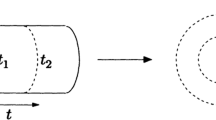Abstract
The purpose of this contribution is to show howa nuclear field theory follows naturally from thestructure of four-dimensional Riemannian geometry. AYang-Mills field is introduced by constructing fibers that include all possible exchanges of spin,parity, and charge such that the collective quantumnumbers remain the same. In this way O(4) internalsymmetry transformations are found and a connection is obtained by exponentiation of a CP-invariantoperator C associated with the ground state. The metricis Calabi–Yau and Einstein. Carbon-13 is chosen asan example because it is the lightest nucleus to exhibit small spin mutations even though there is nodeformation parameter in the O(4) commutation relations.Instead, a supersymmetric transformation replaces aquantum group. Mirror symmetry is also discussed and because a density functional approach isused it is possible to regard the nucleus as astatistical ensemble.
Similar content being viewed by others
REFERENCES
Antoniou, I., and Tasaki, S. (1993). International Journal of Quantum Chemistry, 46, 425.
Ashtekar, A. (1988). New Perspectives in Canonical Gravity, Bibliopolis, Naples.
Ashtekar, A., Jacobson, T., and Smolin, L. (1988). Communications in Mathematical Physics, 115, 631.
Atiyah, M. F., Hitchin, N. J., and Singer, I. M. (1978). Proceedings of the Royal Society of London, 362, 425.
Biedenharn, L. C., and Louck, J. D. (1981). Angular momentum in quantum physics, in Encyclopedia of Mathematics, Vol. 8, Addison-Wesley, Reading, Massachusetts.
Capovilla, R., Jacobson, T., and Dell, J. (1990). Classical and Quantum Gravity, 7, L1-L3.
de Wet, J. A. (1971). Proceedings of the Cambridge Philosophical Society, 70, 485.
de Wet, J. A. (1994). International Journal of Theoretical Physics, 33, 1841.
de Wet, J. A. (1995). International Journal of Theoretical Physics, 34, 1065.
de Wet, J. A. (1996). International Journal of Theoretical Physics, 35, 1201.
Eddington, A. S. (1948). Fundamental Theory, Cambridge University Press, Cambridge.
Green, M. B., Swartz, J. H., and Witten, E. (1993). Superstring Theory, 4th ed., Cambridge University Press, Cambridge.
Lawson, H. B., and Michelsohn, M.-L. (1989). Spin Geometry, Princeton University Press, Princeton, New Jersey.
Kobayashi, S., and Nomizu, K. (1969). Foundations of Differential Geometry, Wiley-Interscience, New York.
Manin, Y. I. (1991). Topics in Non-Commutat ive Geometry, Princeton University Press, Princeton, New Jersey
Prigogine, I. (1995). International Journal of Quantum Chemistry, 53, 105.
Salamon, S. (1989). Riemanian Geometry and Holonomy Groups, Longmans Scientific, Essex, England.
Strominger, A., Yau, S.-T., and Zaslow, E. (1996). Nuclear Physics B, 479, 243.
Wong, Y.-C. (1967). Proceedings of the National Academy of Science, 57, 589.
Rights and permissions
About this article
Cite this article
de Wet, J.A. Nuclear Field Theory with Chiral Symmetry on a Calabi–Yau Manifold. International Journal of Theoretical Physics 37, 2027–2041 (1998). https://doi.org/10.1023/A:1026625615977
Issue Date:
DOI: https://doi.org/10.1023/A:1026625615977




